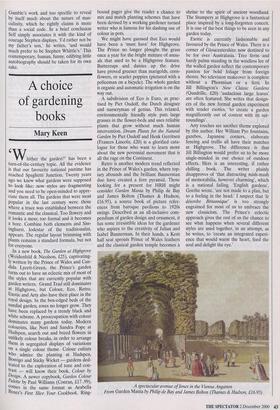A choice of gardening books
Mary Keen
Whither the garden?' has been a turn-of-the-century topic. All the evidence is that our favourite national pastime has reached Spaghetti Junction. Twenty years ago we knew what gardens were supposed to look like; now styles are fragmenting and you need to be open-minded to appre- ciate them all. The gardens that were most popular in the last century were those Where a truce was established between the romantic and the classical. Too flowery and it looks a mess; too formal and it becomes a bore. Combine both elements and Siss- inghurst, lodestar of the traditionalist, appears. The regular layout brimming with Plants remains a standard formula, but not for everyone.
In a new book, The Garden at Highgrove (Weidenfeld & Nicolson, £25), captivating- ly written by the Prince of Wales and Can- dida Lycett-Green, the Prince's garden turns out to have an eclectic mix of most of the styles that are currently popular with garden writers. Grand Trad still dominates at Highgrove, but Colour, Eco, Retro, Exotic and Arty also have their place in the royal design. In the box-edged beds of the sundial garden, roses no longer grow. They have been replaced by a trendy black and White scheme. A preoccupation with colour dominates many gardens today. Modern colourists, like Non i and Sandra Pope at Hadspen, search out and breed flowers in unlikely colour breaks, in order to arrange them in segregated displays of variations on a single colour theme. Colour cultists Who admire the planting at Hadspen, B. osvigo and Sticky Wicket — gardens ded- icated to the exploration of tone and con- trast — will know their book, Colour by Design. A newer copybook, Garden Colour Palette by Paul Williams (Conran, £17 .99), comes in the same format as Arabella Boxer's First Slice Your Cookbook. Ring- bound pages give the reader a chance to mix and match planting schemes that have been devised by a working gardener turned writer who is famous for his dashing use of colour in pots.
We might have guessed that Eco would have been a 'must have' for Highgrove. The Prince no longer ploughs the grass once a year for the bright mixture of annu- als that used to be a Highgrove feature. Buttercups and daisies up the drive have proved greener than marigolds, corn- flowers, or scarlet poppies (pictured with a policeman on a bicycle). The whole garden is organic and automatic irrigation is on the way out.
A subdivision of Eco is Euro, as prac- tised by Piet Oudolf, the Dutch designer and nurseryman of genius. This relaxed, environmentally friendly style puts large grasses in the flower-beds and uses reliable plants that grow without much human intervention. Dream Plants for the Natural Garden by Piet Oudolf and Henk Gerritsen (Frances Lincoln, £20) is a glorified cata- logue for those who want to learn more about the new perennial movement that is all the rage on the Continent.
Retro is another modern trend reflected in the Prince of Wales's garden, where top- iary abounds and the brilliant Bannerman duo have created a fern pyramid. Those looking for a present for HRH might consider Garden Mania by Philip de Bay and James Bolton (Thames & Hudson, £16.95), a source book of picture refer- ences from baroque pavilions to 1920s swings. Described as an all-inclusive com- pendium of garden design and ornament, it has some irresistible ideas for the gardener who aspires to the creativity of Julian and Isabel Bannerman. In their hands, a Kent hall seat sprouts Prince of Wales feathers and the classical garden temple becomes a shrine to the spirit of ancient woodland. The Stumpery at Highgrove is a fantastical place inspired by a long-forgotten conceit. It is one of the best things to be seen in any garden today.
Exotic is currently fashionable and favoured by the Prince of Wales. There is a corner of Gloucestershire now destined to be for ever Australasia. Tree ferns and hardy palms standing in the windless lee of the walled garden reflect the contemporary passion for bold foliage from foreign shores. No television makeover is complete without a Phormium or a fern. In Jill Billington's New Classic Gardens (Quadrille, £20) 'audacious large leaves' are often featured. She writes that design- ers of the new formal garden experiment with tender exotics, 'to create a garden magnificently out of context with its sur- roundings'.
Arty touches are another theme explored by this author. Her William Pye fountains, gazebos, Japanese corners, elaborate fencing and trellis all have their matches at Highgrove. The difference is that Jill Billington would prefer us to be more single-minded in our choice of outdoor effects. Hers is an interesting, if rather chilling book. The writer plainly disapproves of 'that distracting mish-mash of memorabilia, however charming', which is a national failing. 'English gardens', Goethe wrote, 'are not made to a plan, but to a feeling in the head.' I suspect that 'le desordre Britannique' is too strongly engrained for most of us to embrace the new classicism. The Prince's eclectic approach gives the rest of us the chance to see what happens when several different styles are used together, in an attempt, as he writes, to 'create an integrated experi- ence that would warm the heart, feed the soul and delight the eye.'


















































































 Previous page
Previous page